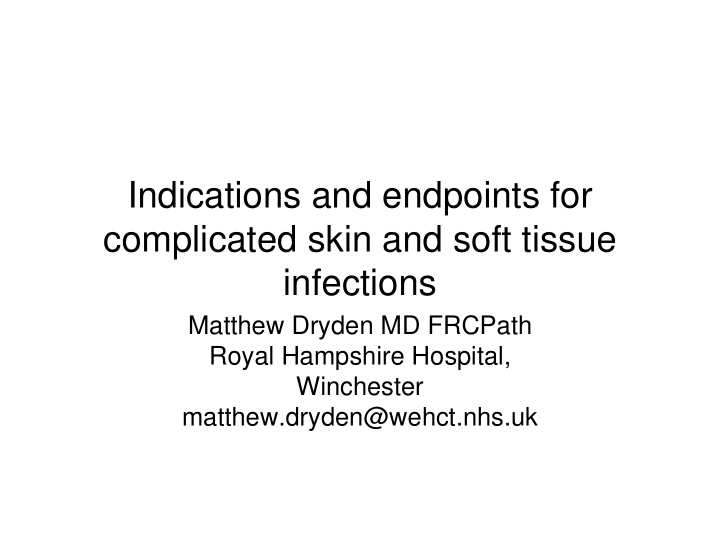



Indications and endpoints for complicated skin and soft tissue infections Matthew Dryden MD FRCPath Royal Hampshire Hospital, Winchester matthew.dryden@wehct.nhs.uk
Main clinical indications • Cellulitis / erisipelas • Major soft tissue abscess • Surgical wound infection • Infected burn • Diabetic foot infection • Infected ischaemic ulcer • Min surface area of 75cm 2 of erythema, swelling or induration
Cellulitis (loose subcutaneous tissue) Streptococci -haemolytic (Strep. pyogenes)
Erysipelas – intradermal infection Streptococci -haemolytic (Strep. pyogenes)
Necrotising fasciitis • GAS or polymicrobial • anaerobes often involved
Clinical inclusion criteria • Erythema • Swelling • Warmth • Discharge • Pain • Fever > 38 o C
Microbiological criteria • Infection site needs to be sampled • Punch biopsy • Aspirate • Deep swab • Tissue • MRSA important in USA. Therefore FDA recommends that MRSA cases should be included
Exclusion • Recent antibiotic use. How long? • Except – Surgical prophylaxis – Empirical treatment – Treatment failure • Immunocompromised • Osteomyelitis • Diabetic foot infection / ischaemic leg • Chronic use of antipyretics
Primary efficacy endpoint and timing of assessments for a noninferiority trial in ABSSSI • Clinical response or clinical failure at 48 to 72 hours • Cessation of the spread of the redness, oedema, and/or induration • Fall in fever • NB controversy over when to assess efficacy endpoint: 72 hours or post- treatment
Evaluation and endpoints • Primary – Clinical outcome at end-of-study visit or test- of-cure visit • Secondary – Microbiological outcome at EOT and EOS visits – Clinical outcome at EOT visit
Other secondary endpoints • Safety and tolerability • Population PK data • Duration of hospital stay • Duration of IV therapy • Medical resource use
FDA recommendations 2010
Clinical failures – FDA 2010 • Death – all causes • Unplanned surgery or aspiration • Persistent purulent discharge • Initiating another antibiotic • Patients who do not show reduction in size at 72 hours or resolution of lesion at 10 days and follow up visits
Evaluation 2011 trial
Discussion
Recommend
More recommend